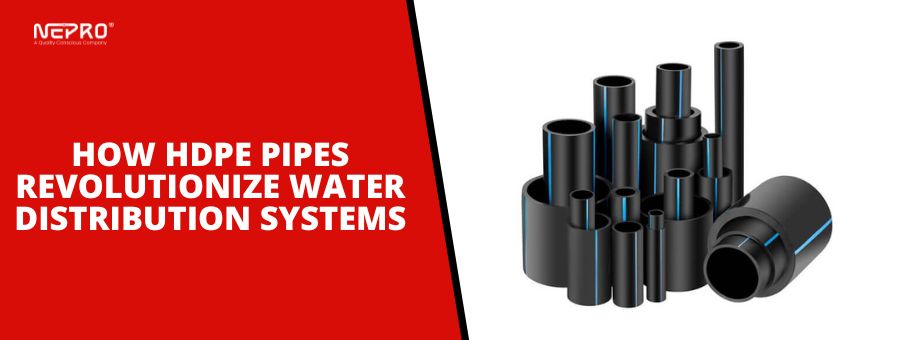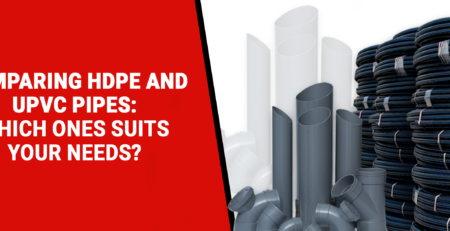HDPE Pipes and Their Role in Water Distribution
HDPE pipes, made from high-density polyethylene, are transforming water distribution systems worldwide. Their versatility, strength, and efficiency make them an ideal choice for various applications, from municipal water supply networks to industrial and agricultural systems. In Pakistan, where water management is critical, the adoption of HDPE pipes is paving the way for more reliable and sustainable infrastructure.
Key Advantages of High-Density Polyethylene Pipes
Durability and Resistance to Corrosion
One of the most significant advantages of HDPE pipes is their durability. Unlike traditional materials such as steel or iron, HDPE pipes are resistant to corrosion, ensuring a long service life even in challenging environments. They withstand exposure to chemicals, UV rays, and moisture, making them suitable for diverse climates and applications.
Flexibility and Lightweight Design
HDPE pipes are both flexible and lightweight, simplifying transportation and installation. Their flexibility allows them to bend and adapt to the terrain, reducing the need for fittings and minimizing installation costs. This characteristic is particularly valuable in Pakistan’s varied landscapes, where terrain and climatic conditions demand adaptable solutions.
HDPE Pipe Fittings: Ensuring Efficiency and Reliability
Types of HDPE Pipe Fittings
HDPE pipe fittings are designed to connect and secure pipes in water distribution systems. Common types include couplers, elbows, tees, and reducers. These fittings ensure leak-proof connections, enhancing the overall efficiency and reliability of the system.
Compatibility with Modern Infrastructure
HDPE pipe fittings are compatible with advanced infrastructure technologies, such as automated control systems and smart water networks. Their ease of integration ensures seamless operation and maintenance, which is essential for modern water distribution projects in urban and industrial settings.
Applications of HDPE Pipes in Water Distribution Systems
Urban Water Supply
HDPE pipes are a preferred choice for urban water supply systems due to their durability and low maintenance requirements. They provide a reliable solution for transporting potable water, ensuring consistent supply to residential and commercial areas.
Industrial Water Management
In industrial settings, HDPE pipes are used for transporting water and other fluids. Their resistance to chemicals and high temperatures makes them suitable for demanding applications, such as cooling systems and wastewater management.
Rural and Agricultural Usage
In rural areas, HDPE pipes support irrigation systems and drinking water supply. Their affordability and ease of installation make them an effective solution for improving water access in remote locations. In Pakistan, HDPE pipes are playing a crucial role in enhancing agricultural productivity by enabling efficient water distribution.
Comparison: HDPE Pipes vs. Traditional Water Supply Pipes
HDPE pipes offer numerous advantages over traditional materials like steel, iron, and concrete. Unlike metal pipes, HDPE pipes do not rust or corrode, ensuring a longer lifespan. They are also lighter and easier to handle, reducing labor costs and installation time. Additionally, their flexibility and resistance to environmental stress cracking make them a more reliable choice for modern water distribution systems.
Traditional pipes, while sturdy, require regular maintenance and are prone to leaks and damage over time. This results in higher operational costs and frequent disruptions, which can be mitigated by using HDPE pipes. The cost-effectiveness and superior performance of HDPE pipes make them a preferred option for infrastructure projects in Pakistan and beyond.
Role of HDPE Pipes in Pakistan’s Water Infrastructure Development
Pakistan faces significant challenges in water management, including scarcity, outdated infrastructure, and inefficiencies in distribution. HDPE pipes address these challenges by providing a reliable and cost-effective solution for water supply systems. Their resistance to leaks and contamination ensures the delivery of clean and safe water to communities and industries.
In addition to urban and rural water supply projects, HDPE pipes are being used in irrigation systems to optimize water usage in agriculture. By reducing water loss and enhancing distribution efficiency, these pipes contribute to sustainable water management practices, which are critical for Pakistan’s economic and social development.
Future Trends in High-Density Polyethylene Pipes for Water Systems
The future of HDPE pipes lies in innovation and sustainability. Advancements in material science are leading to the development of stronger and more eco-friendly variants of HDPE. For example, bio-based HDPE and recycled HDPE are gaining traction as sustainable alternatives.
Smart technologies are also being integrated into HDPE piping systems. Features like real-time monitoring and automated leak detection are enhancing the functionality and reliability of water distribution networks. In Pakistan, the adoption of such technologies can revolutionize water infrastructure, improving efficiency and reducing water wastage.
Furthermore, the demand for HDPE pipes is expected to grow as the country invests in large-scale infrastructure projects. With an emphasis on sustainability and resilience, HDPE pipes will continue to play a vital role in shaping the future of water distribution systems in Pakistan.
Conclusion: Enhancing Water Distribution with HDPE Pipes
HDPE pipes are redefining the standards of water distribution systems, offering unmatched durability, efficiency, and versatility. From urban water supply to agricultural irrigation, these pipes cater to a wide range of applications, addressing the diverse needs of Pakistan’s infrastructure. As the country progresses towards sustainable development, HDPE pipes and fittings stand out as a cornerstone of modern water management solutions. By prioritizing their adoption, Pakistan can ensure a more reliable and efficient water distribution network for the future.




Leave a Reply